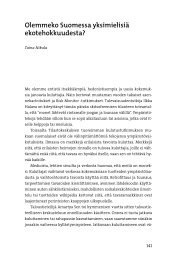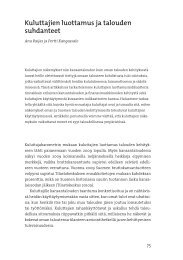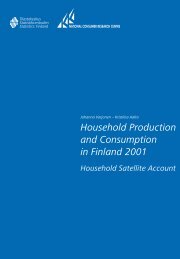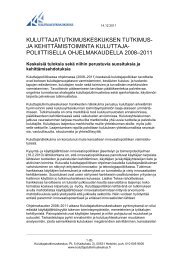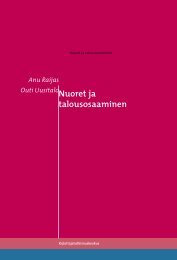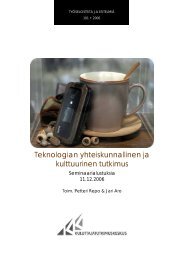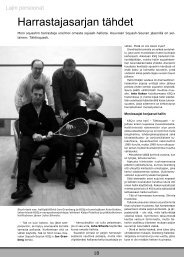Household Production and Consumption in Finland 2001
Household Production and Consumption in Finland 2001
Household Production and Consumption in Finland 2001
Create successful ePaper yourself
Turn your PDF publications into a flip-book with our unique Google optimized e-Paper software.
The eat<strong>in</strong>g of snacks has become <strong>in</strong>creas<strong>in</strong>gly common, <strong>and</strong> for this reason<br />
it was considered necessary that these products should be identified as f<strong>in</strong>al<br />
consumption goods. Also all alcoholic beverages are def<strong>in</strong>ed as f<strong>in</strong>al<br />
consumption goods, although sometimes they are also used as <strong>in</strong>gredients to<br />
prepare mixed dr<strong>in</strong>ks, <strong>and</strong> <strong>in</strong> some households w<strong>in</strong>e <strong>and</strong> beer are an <strong>in</strong>tegral<br />
part of meals. In the UK <strong>and</strong> Germany, all dairy products <strong>and</strong> fruits were<br />
def<strong>in</strong>ed as <strong>in</strong>termediate consumption goods, but bread <strong>and</strong> some vegetables<br />
(French fries) were classified as f<strong>in</strong>al consumption goods (<strong>Household</strong><br />
production… 2003). In other words there may be country differences here<br />
that have to do with different food cultures.<br />
It is important to rem<strong>in</strong>d here that <strong>in</strong> the <strong>in</strong>put method, the number of<br />
<strong>in</strong>termediate consumption products does not affect the amount of value<br />
added, which is the sum of labour, capital <strong>and</strong> taxes on production m<strong>in</strong>us<br />
subsidies. Intermediate consumption goods are, however, <strong>in</strong>cluded <strong>in</strong> the value<br />
of the total output.<br />
Results <strong>in</strong>dicate that eat<strong>in</strong>g out <strong>and</strong> ready-to-eat foods still play a fairly<br />
limited role <strong>in</strong> the meal management of F<strong>in</strong>nish families. Figure 5 shows the<br />
values of the meals, snacks <strong>and</strong> alcoholic beverages consumed by households <strong>in</strong><br />
percentage terms <strong>in</strong>clud<strong>in</strong>g the consumption of household-produced meals<br />
(SNA <strong>and</strong> non-SNA food). Shopp<strong>in</strong>g <strong>and</strong> related travel for the acquisition of<br />
meals is shown separately. The relative proportions of f<strong>in</strong>al consumption goods<br />
<strong>and</strong> <strong>in</strong>termediate consumption goods are discussed also <strong>in</strong> Chapter 6.<br />
Cloth<strong>in</strong>g <strong>and</strong> cloth<strong>in</strong>g care<br />
Cloth<strong>in</strong>g care <strong>in</strong>cludes wash<strong>in</strong>g, iron<strong>in</strong>g, repairs, etc. The home production of<br />
clothes is very rare. In 2003 Kristi<strong>in</strong>a Aalto reported that less than 3 per cent<br />
of women <strong>in</strong> F<strong>in</strong>l<strong>and</strong> made clothes for themselves or household members on a<br />
regular basis, <strong>and</strong> 7 per cent produced textiles, sharply down on earlier figures<br />
(Aalto 2003, Niemi & Pääkkönen <strong>2001</strong>). Most purchases now are for<br />
ready-to-wear clothes, which is reflected <strong>in</strong> shopp<strong>in</strong>g, services <strong>and</strong> travel<br />
account<strong>in</strong>g for a large proportion of production (Figure 6). Overall the share of<br />
<strong>in</strong>termediate consumption goods is rather low. One-fifth of it consists of<br />
energy <strong>and</strong> water consumption. Laundry accounts for 14 per cent of<br />
households’ water consumption <strong>and</strong> for just over 4 per cent of electricity<br />
consumption (Appendix 8).<br />
In <strong>2001</strong> people <strong>in</strong> F<strong>in</strong>l<strong>and</strong> spent a total of 9.3 billion euros on cloth<strong>in</strong>g <strong>and</strong><br />
cloth<strong>in</strong>g care. Almost three-quarters or 71 per cent of this was attributable to<br />
own production. Figure 7 shows how the overall consumption of cloth<strong>in</strong>g <strong>and</strong><br />
cloth<strong>in</strong>g care breaks down between own household production <strong>and</strong> the<br />
purchase of clothes <strong>and</strong> related services. Own production consists ma<strong>in</strong>ly of<br />
wash<strong>in</strong>g <strong>and</strong> other care of clothes, while services purchased from market<br />
producers consist of ready-to-wear clothes <strong>and</strong> laundry services. Shopp<strong>in</strong>g <strong>and</strong><br />
travel account for one-fifth.<br />
40 Statistics F<strong>in</strong>l<strong>and</strong> National Consumer Research Centre




